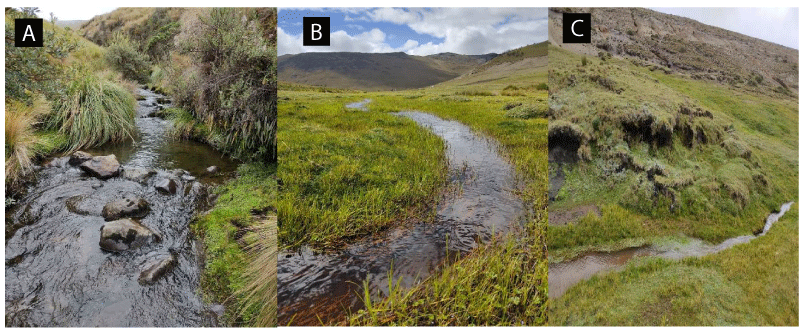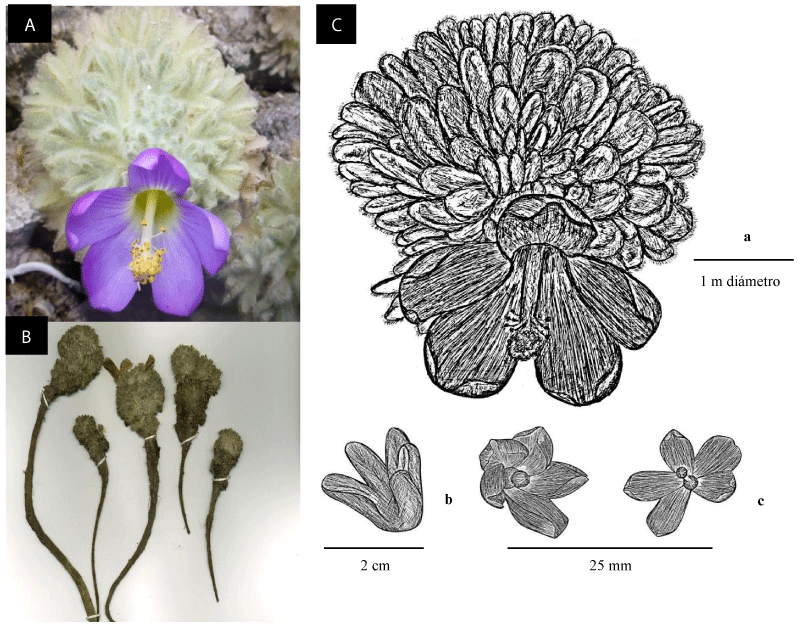Global Journal of Ecology
New geographic distribution area of the specie Nototriche hartwegii A.W. Hill, 1909 (Malvaceae: Malvales) in the wetlands of Central Ecuador
Juan Carlos Carrasco Baquero1,2**, Daisy Carolina Carrasco López3 and Verónica Lucía Caballero Serrano1
Cite this as
Carrasco Baquero JC, Carrasco López DC, Caballero Serrano VL (2022) New geographic distribution area of the specie Nototriche hartwegii A.W. Hill, 1909 (Malvaceae: Malvales) in the wetlands of Central Ecuador. Glob J Ecol 7(2): 040-044. DOI: 10.17352/gje.000057Copyright
© 2022 Carrasco Baquero JC, et al. This is an open-access article distributed under the terms of the Creative Commons Attribution License, which permits unrestricted use, distribution, and reproduction in any medium, provided the original author and source are credited.Nototriche hartwegii A.W. Hill, 1909 (Malvaceae: Malvales), is recorded for the first time in the province of Bolívar, in the wetlands of the Andean plateau of the Chimborazo Fauna Production Reserve (RPFCH). With this record, the endemic and limited distribution of this species to the wetlands of southern Ecuador, between 4100 and 4400 m.a.s.l., specifically in the provinces of Cañar and Azuay, is extended to the moorlands of central Ecuador.
Introduction
High Andean wetlands known locally as wetlands, are part of the paramo ecosystems and are composed of micro-watersheds, peat, and very specific perennial vegetation [1,2]. In Ecuador, 13 Ramsar wetlands have been registered [3], and 59 wetlands cover a total area of 286,659 hectares [4].
The Chimborazo Fauna Production Reserve is part of Ecuador’s National System of Protected Areas (Ministerio del Ambiente, Agua y Transición Ecológica [5]. It has an area of 58560 hectares (Sistema Nacional de Áreas Protegidas, [6], of which 39% of the ecosystems are bofedal type: 24% of the wetland ecosystem is in the intervened category, 12% is moderately conserved, while the remaining 3% is conserved [4].
The vegetation of the wetlands allows the interaction between terrestrial and aquatic ecosystems [7], conditions the physical-chemical properties of the water soil, and fixes atmospheric carbon dioxide [2,8]. Flores [9], in his study, determined that the botanical composition of wetlands consists of 59.5% of herbaceous or forbs, 12.3% of graminoids or sedges, and 16.4% of grasses and 11.7% of other miscellaneous species.
During the last years, a series of scientific works have been reporting the appearance of the species of the genus Nototriche [10]. In his study Hill (1909) [11] presented a total of 62 species, however, later works by Krapovickas [12-16], increased the number of known species.
This genus is distributed in the punas of Peru, Chile, Bolivia, northern Argentina, and the paramos of Ecuador [17]. Fryxell [18], in his monograph for Ecuador, presented three species: N. ecuadoriensis, N. fryxell, and N. jamesonii, however, collections made in the south of Ecuador, recorded the presence of a fourth species, N. hartwegii A.W. Hill (Chanco & Ulloa, 2004), thus demonstrating that it is a very different species from the rest of the collections of N. jamesonii.
This study represents the first record of the species Nototriche hartwegii, in the paramos of the central part of the country, specifically in the province of Bolivar (Figure 1). Previous studies showed that this species had a distribution restricted to the moorlands of the south of the country, which was protected within the Cajas National Park; however, it is considered endangered due to its small distribution area according to the categories of the Red Book of endemic plants of Ecuador [19]. Thus, this study shows a much wider distribution of the species, showing that its presence in Ecuador has probably not been previously reported due to lack of collection.
Materials and methods
In the floristic inventory conducted in the bofedales of the Andean plateau of the RPFCH in Ecuador, specimens of Nototriche hartwegii were collected that were not recorded for this area of the country. Specimens were collected in September 2019 (Table 1). The specimens were identified and verified in the herbarium of the Department of Biological Sciences of the Pontificia Universidad Catolica del Ecuador in Quito (Herbario QCA).
Results
Specimens were recorded in the ecosystems paramo flooded grassland (3300-4500 m.a.s.l.) and paramo upper montane wet grassland (3500-4200 m.a.s.l.)[5], on the margins of the wetlands: Puente Ayora BNI, Pachancho BI, and Cruz del Arenal BNI, in terrestrial habitats, forming scattered communities (Figure 2). It is characterized by the presence of a stellate-vilose lamina with long silky hairs; a free part of the petiole 2-3 mm long and leafy aerial branches forming cylinders up to 15 cm long x 4-5 cm in diameter [11].
This new record expands the known distribution range of the species to the paramos of the central part of the country, thus adding the genus Nototriche to the list of species present in the bofedales of the RPFCH.
Nototriche hartwegii (Figure 3)
Common name: Lechuguilla
Taxonomy: Perennial herb in pads up to 1 m in diameter [17] (Figure 3), acaulescent, pulviniform; woody, branched subway axis on whose branch apices numerous leaves are grouped forming compact masses [10]. The stipules and petiole form a vagina 6-7 mm long x 3-4 mm wide. The free part of stipules linear, subacute apex, 5-9 mm long x 0.7-1 mm wide. The free part of the petiole is 2-3 mm long. Petiole, stipules, and vagina are densely covered by long, smooth stellate pubescence on both surfaces, at margins with larger pedicellate stellate hairs. It is worth mentioning that at the time of collection the specimens were not in flowering season.
Discussion
Existing records of this species indicate that it is endemic to the paramos of southern Ecuador between 4100 and 4400 m.a.s.l., specifically in the provinces of Cañar and Azuay [10]. However, data obtained from The Global Biodiversity Information Facility [21], in its update to date, reports only 20 records in the country, most of which are found in the southern provinces and a few in the province of Imbabura, in the north of the country.
These studies recognize the small populations of this species [17]. It is currently protected within Cajas National Park; however, it is considered Endangered due to its very small range [19].
Protected areas constitute a fundamental piece of national and international conservation strategies [21]. In Ecuador, the areas included in the SNAP cover approximately 18% of the continental territory [5] and have extreme plant diversity [22,23]. So far it has been possible to observe a great floristic diversity in these ecosystems at the national level [24].; however; the exact number of plant species living in the paramos of Ecuador is not yet known, but it is estimated to be around 1,500 [25].
In their studies Mena and Medina [25], identified that the paramo families with the greatest number of endemic species for Ecuador are Orchidaceae, Asteraceae, Gentianaceae, Campanulaceae, and Brassicaceae, as the five families richest in Ecuadorian endemic species, adding to them now the family Malvaceae with its species Nototriche hartwegii A.W. Hill [19].
Conclusion
The species range summarizes the evolutionary and ecological history and physiological needs of a species, which is determined by biogeographic, physiological, and ecological factors, making it a difficult attribute to estimate. In fact, this study represents the first floristic approach in which a new distribution record is reported for Nototriche hartwegii in the wetlands of the RPFCH.
Undoubtedly, technological advances generate predictive models to determine new areas of species distribution, opening the doors to new branches of science such as predictive biogeography. In this context, it is necessary to carry out exhaustive studies and formal descriptions of Nototriche hartwegii, which allow determining new areas of geographic space and spatial dimensions for this species, demonstrating the importance of continuing with research and botanical expeditions, generating new knowledge about the diversity of the wetlands.
Financing
Escuela Superior Politécnica de Chimborazo (ESPOCH), Research Institute (IDI), research project. “Sistemas basados en las comunidades de macroinvertebrados acuáticos para la evaluación del estado ecológico de los bofedales de la meseta andina de la Reserva de Producción de Fauna Chimborazo”
Compliance with ethical standards
The authors declare that the article is original, has not been previously published, and has not been submitted to another journal.
- Gardner RC, Finlayson C. Global wetland outlook: state of the World’s wetlands and their services to people. In Ramsar convention secretariat. 2018; 2020-2025.
- Garcia E, Otto M. Caracterización ecohidrológica de humedales alto andinos usando imágenes de satélite multitemporales en la cabecera de cuenca del río Santa, Ancash, Perú. Ecología Aplicada. 2015; 14(2): 115-125.
- Flachier A, Chinchero M, Lima P, Villarroel M. Caracterización ecológica de las turberas y bofedales del sistema de humedales Amaluza, nudo de Sabanilla, provincia de Loja, Ecuador. Proyecto de Gestión de Humedales Altoandinos. EcoCiencia–Ministerio del Ambiente, Quito. 2009.
- Jara C, Delegido J, Ayala J, Lozano P, Armas A, Flores V. Estudio de bofedales en los Andes ecuatorianos a través de la comparación de imágenes Landsat-8 y Sentinel-2. Revista de teledetección. 2019; 45-57.
- Ministerio del Ambiente. (2014) Sistema Nacional de Áreas Protegidas. http://www.ambiente.gob.ec/wp-content/uploads/downloads/2014/10/MAEBoleti%CC%81n-SOMOS-07-final.pdf
- Sistema Nacional de Áreas Protegidas (2015) Reserva de Producción de Fauna Chimborazo. http://areasprotegidas.ambiente.gob.ec/areasprotegidas/reserva-de- producci%C3%B3n-faun%C3%ADstica-chimborazo
- Ramos Montaño C, Cárdenas-Avella NM, Herrera Martínez Y. Characterization of the Community of Aquatic Macrophytes in Lakes of La Rusia Paramo (Boyacá-Colombia). Ciencia en Desarrollo. 2013; 4(2): 73-82.
- Poveda-Cuellar JL, López-Delgado EO, Villa-Navarro FA. Efecto de la cobertura vegetal de ribera en las comunidades ícticas en el bosque húmedo premontano y muy húmedo premontano del Alto Magdalena, Colombia. Revista de la Academia Colombiana de Ciencias Exactas, Físicas y Naturales. 2018; 42(163): 216-226.
- Flores-Franco G. La Subfamilia Caesalpinoideae (Familia Leguminosae) en el estado de Morelos. Universidad Autónoma del Estado de Morelos. México. 1990; 135.
- Chanco M, Ulloa CU. Las especies de Nototriche (Malvaceae) de Ecuador. Sida, Contributions to Botany. 2004; 693-703.
- Hill AW. XII. A Revision of the Genus Nototriche, Turcz. Transactions of the Linnean Society of London. 2nd Series: Botany. 1909; 7(12): 201-266.
- Krapovickas A. Una nueva especie del género Nototriche (Malvaceae). Ministerio de Agricultura y Ganaderia de la Nación, Dirección General de Investigaciones Agrícolas, Instituto de Botánica. 1950.
- Krapovickas A. Monteiroa, nuevo género de Malváceas. Bol Soc Argent Bot. 1951; 3(4): 235-244.
- Krapovickas A. Notas Cito-Taxonómicas sobre Nototriche (Malvaceae). Bol Soc Argent Bot. 1953. 11(1), 1-74.
- Krapovickas A. Tres Especies Neuvas de Nototriche (Malvaceae) de Peru. 1957.
- Krapovickas A. Sobre las especies polígamas de Nototriche (Malvaceae). Lilloa. 1957; 269-277.
- Minga Ochoa DA, Ansaloni R, Verdugo A, Ulloa Ulloa C. Flora del páramo del Cajas, Ecuador (Bachelor's thesis, Universidad del Azuay). 2016.
- Fryxell P. MALVACEAE. Instituto de Ecología. 1992. http://www1.inecol.edu.mx/publicaciones/resumeness/FLOVER/68-fryxell_I.pdf
- León-Yánez S, Valencia R, Pitman N, Endara L, Ulloa C, Navarrete H. Libro rojo. Pontificia Universidad Católica del Ecuador, Quito. 2017.
- Global Biodiversity Information Facility (2021).Occurrence Nototriche hartwegii. https://doi.org/10.15468/dl.r789dx
- Daily GC, Matson PA. Ecosystem services: from theory to implementation. Proc Natl Acad Sci U S A. 2008 Jul 15;105(28):9455-6. doi: 10.1073/pnas.0804960105. Epub 2008 Jul 9. PMID: 18621697; PMCID: PMC2474530.
- Richter M. Using epiphytes and soil temperatures for eco-climatic interpretations in southern Ecuador (Der Nutzen von funktionalen Pflanzentypen und Bodentemperaturen für klimaökologische Interpretationen in Süd-Ecuador). Erdkunde. 2003; 161-181.
- Richter M, Moreira-Muñoz A. Heterogeneidad climática y diversidad de la vegetación en el sur de Ecuador: un método de fitoindicación. Revista peruana de Biología. 2005; 12(2): 217-238.
- Vásconez P, Hofstede R. Los páramos ecuatorianos. Botánica Económica Los Andes Cent. 2006; 91-109.
- Mena Vásconez P, Medina G. La biodiversidad de los páramos en el Ecuador. Los Páramos de Ecuador. Particularidades, Problemas y Perspectivas, Editorial Abya Yala, Quito. 2001; 27-52.
- Andrade Muñoz JM. Determinación del estado de conservación de los bofedales de la Reserva de Producción de Fauna Chimborazo (Bachelor's thesis, Escuela Superior Politécnica De Chimborazo). 2006.
Article Alerts
Subscribe to our articles alerts and stay tuned.
 This work is licensed under a Creative Commons Attribution 4.0 International License.
This work is licensed under a Creative Commons Attribution 4.0 International License.




 Save to Mendeley
Save to Mendeley
